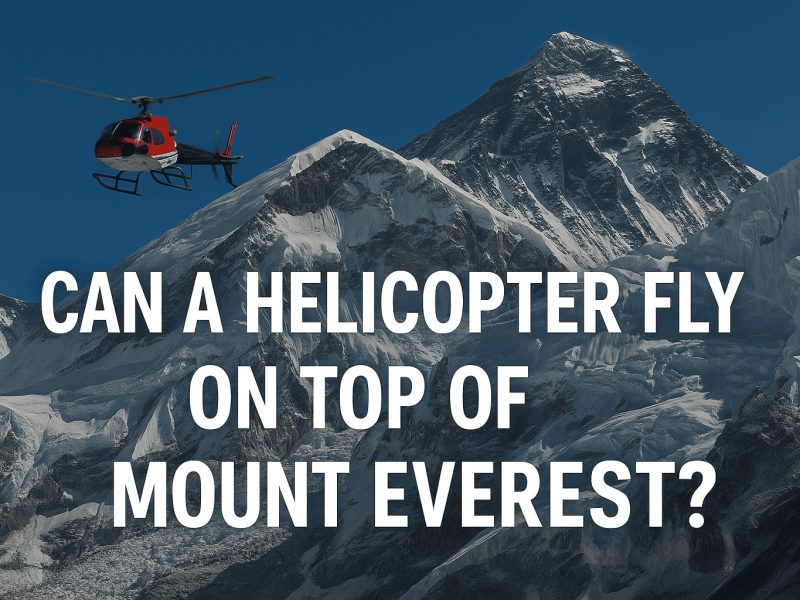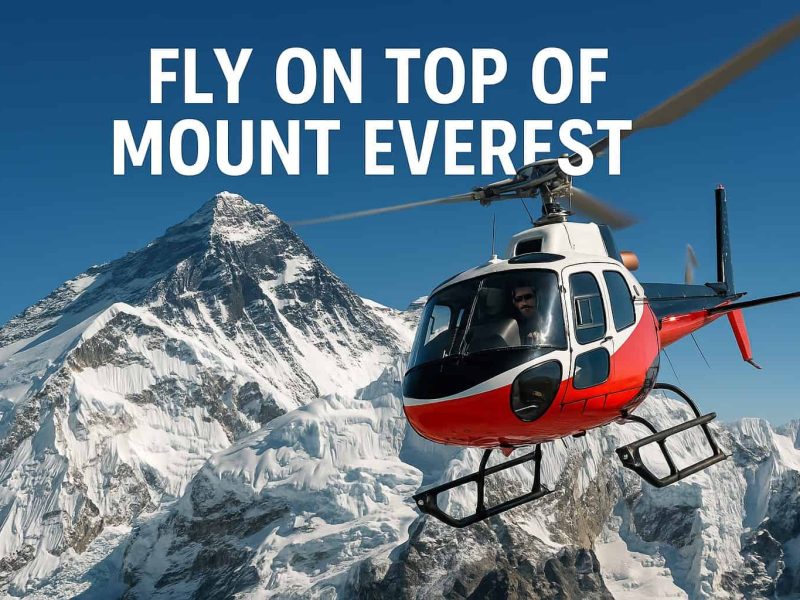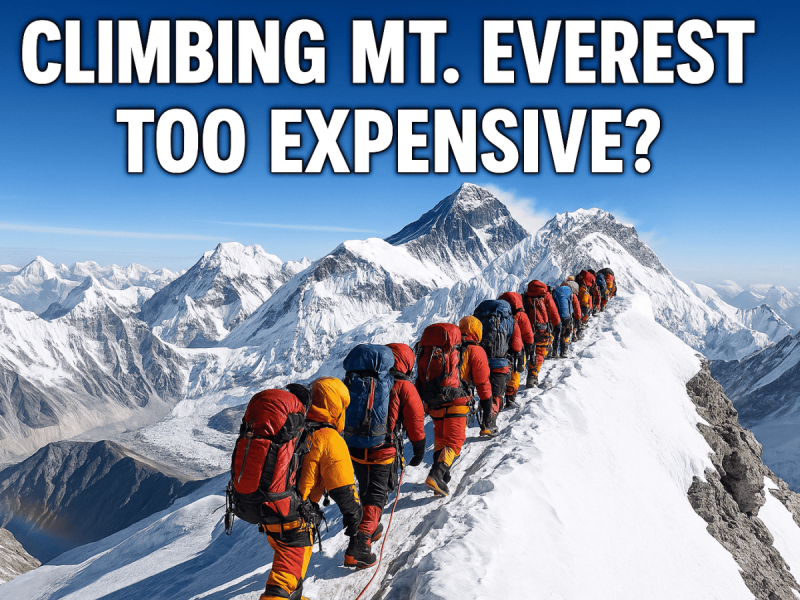
Yes, helicopters can fly to the top of Mount Everest, but it’s incredibly challenging. The air is very thin at such a high altitude, making it hard for helicopters to lift off, hover, or maneuver safely. Only specially designed helicopters with powerful engines—and highly skilled pilots—are capable of operating in these extreme conditions. Although a few successful flights have been made, it remains a rare and difficult achievement.
Mount Everest is the tallest mountain in the world. It is part of the Himalaya mountain range, which stretches across Nepal and Tibet. The summit is always covered in snow because it is extremely cold at that height.
Everest is often called “the roof of the world” because it is the highest point on Earth. No other place on land reaches higher than its peak.
Mount Everest is the highest mountain on Earth because of the way mountains are formed. Mountains grow when large sections of the Earth’s surface, called tectonic plates, push against each other. The Himalayas, including Everest, began forming millions of years ago when two massive plates collided.
Even today, Mount Everest continues to grow. Each year, it rises by about 4 millimeters as the tectonic plates keep pushing upward. This ongoing movement is why Everest remains the tallest mountain in the world.
A helicopter is a special kind of aircraft that can move in all directions—up, down, forward, and backward—and can even hover in one spot in the air.
Unlike airplanes, helicopters don’t need a long runway to take off or land. They can rise straight up from the ground, making them ideal for use in areas where airplanes can’t operate.
Didier Delsalle, born on May 6, 1957, in Aix-en-Provence, France, is a former fighter pilot and an accomplished helicopter test pilot. On May 14, 2005, he made aviation history by becoming the first—and so far, the only—person to successfully land a helicopter on the summit of Mount Everest. Piloting a Eurocopter AS350 Squirrel, he touched down on the world’s highest peak at an altitude of 8,848 meters (29,030 feet).
The Everest Base Camp Helicopter Tour with landing offers a breathtaking journey that begins with a scenic 45-minute flight from Kathmandu to Lukla. From there, you’ll soar high above the Himalayas and reach Everest Base Camp or Kala Patthar in just 25 minutes. Once there, you’ll have approximately 5 minutes of ground time to enjoy the stunning views of the world’s highest mountain. After soaking in the majestic scenery, you’ll fly back to Kathmandu, completing a once-in-a-lifetime adventure in just a few unforgettable hours.
The term “death zone” refers to the extreme altitude of 8,000 meters (26,000 feet) above sea level on Mount Everest. At this height, the oxygen level is so low that it begins to cause severe damage to the human body—cells start to die, and vital functions rapidly decline. Most climbers who have lost their lives on Everest did so in this perilous part of the mountain.
Helicopter rescues on Mount Everest are possible, particularly from Base Camp and the lower camps such as Camp 1 and Camp 2. However, rescues above Camp 2 are extremely rare due to the thin air and dangerous flying conditions at higher altitudes. Weather is a major factor—strong winds, snow, and poor visibility can delay or even prevent helicopter rescue operations.
Without insurance, the cost of booking a helicopter ride to Mount Everest ranges from $2,500 to $4,500. The exact price depends on your starting point and the size of your group. Helicopter rescues are also common in the Everest region, especially among trekkers and climbers heading for peaks like Lobuche and Mera Peak.
A helicopter uses large spinning blades called rotors to fly. These rotors spin quickly and push air downward, which creates lift and allows the helicopter to rise into the air.
The pilot controls where the helicopter goes by adjusting the angle of the rotors. By tilting them, the helicopter can move forward, backward, or side to side. It can also hover, meaning it can stay in one spot in the air without moving.
Helicopters rely on air to fly because their spinning rotors push against it to create lift. This lift is what allows the helicopter to rise into the sky.
However, at very high altitudes—such as near the summit of Mount Everest—the air becomes much thinner. With less air for the rotors to push against, it becomes much harder for the helicopter to generate enough lift to take off or fly safely.

Mount Everest is the highest mountain on Earth, towering above all others.
Climbers who reach its summit stand on the tallest point of land in the world — one of the main reasons why Everest is so famous.
Mount Everest stands at an incredible 8,848 meters (29,029 feet) above sea level — that’s nearly as high as the cruising altitude of a jet airplane!
To picture just how tall that is, imagine stacking around 20 Burj Khalifa skyscrapers — the tallest building in the world — one on top of another. That’s the height of Mount Everest!
What’s even more amazing is that Everest is still growing. Due to tectonic activity beneath the surface, the mountain rises by a few millimeters every year.
At higher altitudes, the air becomes thinner, meaning there is less oxygen available for people to breathe.
At the summit of Mount Everest, the air is extremely thin, making it very hard to breathe. That’s why climbers often use oxygen tanks to help them stay alive.
Thin air also affects helicopters. With less air for the rotors to push against, it becomes much harder for helicopters to take off, fly, or land safely.
Helicopters need air to fly because their blades push against it. As the blades spin, they generate lift, which allows the helicopter to rise off the ground.
When there isn’t enough air, the helicopter can’t create enough lift. This is why flying at very high altitudes, such as on Mount Everest, is challenging.
The blades at the top of a helicopter are called rotors. These rotors spin fast, pushing air downward. This action creates an opposite force called lift, which raises the helicopter into the sky.
The pilot controls the helicopter’s movement by changing the angle of the blades. By tilting the rotors, the helicopter can move forward, backward, or sideways. It can even hover, staying still in the air.
As you go higher in the sky, the air becomes thinner. This means there’s less air for the helicopter’s rotors to push against.
When the air is too thin, the helicopter can’t generate enough lift. This makes it difficult to take off, stay airborne, or land safely.
Near the summit of Mount Everest, the air is so thin that most helicopters can’t fly well. Only specially designed helicopters with powerful engines can operate in such extreme heights.
Flying a helicopter on Mount Everest is extremely challenging. The air is very thin, which makes the engines work harder, and the weather conditions are often dangerous.
Due to these difficulties, most helicopters cannot fly close to Everest’s summit. Only specially designed helicopters, flown by expert pilots, can try to reach those heights.
Helicopters rely on air to generate lift. Their blades push against the air to help them rise.
At the summit of Mount Everest, the air is very thin. This thin air makes it difficult for helicopters to produce enough lift to stay airborne.
Even if a helicopter manages to take off, it might not be able to remain in the air for very long.
Helicopter engines require oxygen to operate efficiently. At high altitudes, the air contains less oxygen, which causes the engine to lose power.
With reduced power, helicopters struggle to carry heavy loads or maintain safe flight. This is why most helicopters cannot reach the summit of Everest, but they can fly up to Everest Base Camp.
Mount Everest experiences extremely strong winds that can push helicopters off course, making them difficult to control.
At times, wind speeds can exceed 200 km/h (125 mph), creating dangerous conditions that may cause the helicopter to lose stability or even crash.
Due to these risks, helicopter flights on Everest are very hazardous and are only carried out in emergency situations.
In 2005, a helicopter made history by landing on the summit of Mount Everest for the very first time. This achievement set a world record, as no helicopter had ever reached the top before.
The pilot overcame numerous challenges during the flight but managed to land and take off from the peak successfully.
On May 14, 2005, a French pilot named Didier Delsalle flew a special helicopter all the way to the summit of Mount Everest. He stayed at the very top for around three minutes before flying back down. This remarkable feat remains the first and only time a helicopter has ever landed on Everest’s peak.
Didier Delsalle flew a special helicopter called the Eurocopter AS350 B3, which was built to operate in high-altitude environments.
Before attempting to land on Everest, he tested the helicopter on other tall mountains to ensure it could handle the thin air and strong winds.
To improve performance, he removed extra seats and equipment, making the helicopter lighter and helping the engine work more efficiently in the thin atmosphere.
Despite all the careful preparation, landing on Everest was extremely dangerous. Still, with skillful control, he successfully made history!
Not all helicopters can fly at high altitudes like Mount Everest. The air is very thin up there, and regular helicopters don’t have enough power to operate safely.
But some special helicopters are built to handle these extreme heights. They are stronger and designed to fly in thin air.
High-altitude helicopters are equipped with powerful engines that allow them to fly even when the air has less oxygen. They also feature longer and stronger rotor blades, which generate more lift in thin air. Additionally, some helicopters are made lighter by removing extra seats and equipment, improving their performance in challenging conditions.
Pilots who fly at high altitudes require specialized training. They need to know how to manage thin air, strong winds, and low oxygen levels.
Before attempting challenging flights, they practice flying in high-altitude areas. This experience helps them learn how helicopters perform in thin air.
Because Mount Everest is extremely dangerous, only the most skilled and experienced pilots are permitted to fly near it.
Although helicopters have landed on Mount Everest before, it is a rare occurrence. Flying to the summit is extremely challenging and risky.
The thin air, powerful winds, and freezing temperatures at the top make it difficult for most helicopters to operate safely.
Flying a helicopter to the summit of Everest is extremely risky. The air is very thin, which makes it difficult for the helicopter to generate enough lift.
At such high altitudes, the engine can also lose power due to the lower oxygen levels. If the engine stops working, the helicopter could crash.
Because of these dangers, pilots try to avoid flying all the way to the top unless it is absolutely necessary.
The weather on Mount Everest can change rapidly. One minute the sky might be clear, and the next, strong winds, snowstorms, or thick clouds can appear suddenly.
Near the summit, winds can exceed 200 km/h (125 mph). These intense gusts can easily push a helicopter off its path or even cause it to crash.
Because weather forecasts are never completely accurate, flying to the summit is extremely dangerous.
Helicopters are commonly used for rescue missions on Everest, but they usually operate only at lower altitudes such as Base Camp or Camp 2.
Most climbers who require assistance are located between 6,000 and 7,000 meters (19,500 to 23,000 feet), where helicopters can fly more safely.
Above this height, flying becomes too risky for both the climber and the pilot. This is why rescues near the summit are very rare.
Climbing Mount Everest is extremely dangerous. If climbers become ill or get stranded, they need immediate assistance.
However, because Everest is so tall, rescue operations are challenging. Helicopters can only fly up to certain altitudes, and bad weather often makes rescues even more difficult.
Helicopters are commonly used for rescues on Mount Everest. They can reach Base Camp, which is at 5,364 meters (17,598 feet), and sometimes even fly higher.
When a climber is injured or ill, they are airlifted to a lower altitude where the air is easier to breathe, helping them recover more quickly.
However, helicopters cannot fly during bad weather. Strong winds or heavy snowfall can delay rescue missions until conditions improve.

Most climbers carry radios or satellite phones so they can call for help from Everest Base Camp or nearby climbers if they get into trouble.
Sometimes, Sherpas—expert mountain guides—climb up to assist. They bring extra oxygen, food, or medicine to help the injured climber.
In severe situations, other climbers may try to carry an injured person down the mountain. This is very difficult because of the cold, thin air, and steep trails.
That’s why safety is crucial when climbing Everest. While rescues can happen, they are often challenging and not always guaranteed.
Sure! Here’s a rewritten version of those paragraphs in a clear and simple style:
Can a helicopter fly to the top of Mount Everest? Yes, it can, but it’s very challenging.
In 2005, a special helicopter with an expert pilot successfully landed on Everest’s summit.
Why do most helicopters avoid flying that high? There are many risks involved. The air is very thin, making it hard for helicopters to lift off and stay in the sky. The engines struggle to get enough power, and strong winds can make flying dangerous. The weather can change quickly, and most rescue missions happen at lower, safer altitudes.
So, while flying on Everest is possible, it is rare and risky, only done in special situations.
Nature Heaven Trek and Expedition Nepal is renowned for its exceptional service and meticulous attention to detail. They guide trekkers on unforgettable adventures through the majestic peaks and gentle hills of the Himalayas.
Call/WhatsApp/ Viber : +977-9851218358 | +977-9841937489
Email: info@natureheaventrek.com | natureadventure603@gmail.com
Address: Pakjonal Marga-16, Thamel, Kathmandu, Nepal
Website: https://natureheaventrek.com/
@Copyright 2025 Nature Heaven Treks and Expedition, Kathmandu, Nepal. All Rights Reserved.
Chat with Us